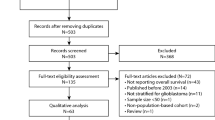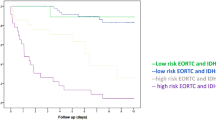Abstract
The current method for assessing the response to therapy of glial tumors was described by Macdonald et al. in 1990. Under this paradigm, response categorization is determined on the basis of changes in the cross-sectional area of a tumor on neuroimaging, coupled with clinical assessment of neurological status and corticosteroid utilization. These categories of response have certain limitations; for example, cross-sectional assessment is not as accurate as volumetric assessment, which is now feasible. Disentangling antitumor effects of therapies from their effects on blood–brain barrier permeability can be challenging. The use of insufficient response criteria might be overestimating the true benefits of drugs in early-stage studies, and, therefore, such therapies could mistakenly move forward into later phases, only to result in disappointment when overall survival is measured. We propose that studies report both radiographic and clinical response rates, use volumetric rather than cross-sectional area to measure lesion size, and incorporate findings from mechanistic imaging and blood biomarker studies more frequently, and also suggest that investigators recognize the limitations of imaging biomarkers as surrogate end points.
Key Points
-
Volume rather than area measurements of tumor burden are now feasible and have less inter-observer variability
-
Non-volumetric reasons for progression including rate of clinical worsening and steroid dosing should be routinely reported in describing the results of clinical trials
-
Mechanistic biomarkers including imaging should be employed wherever posible, especially in early stage trials, to provide more meaning beyond response rates alone
-
Resolution is possible for previously ambiguous aspects of response criteria including minimum lesion size, degree of neurological worsening, definition of what 50% change in size means, degree of enhancement, etc.
-
The advent of new therapies such as antiangiogenic agents that directly affect tumor vessels and tumor enhancement require particular care in response evaluation. FLAIR and/or T2-weighted imaging should be used in addition to T1-weighted post-contrast images
This is a preview of subscription content, access via your institution
Access options
Subscribe to this journal
Receive 12 print issues and online access
$209.00 per year
only $17.42 per issue
Buy this article
- Purchase on Springer Link
- Instant access to full article PDF
Prices may be subject to local taxes which are calculated during checkout





Similar content being viewed by others
References
The Online NewsHour (online 28 March 2007) Extended interview: Janet Woodcock discusses cancer biomarkers. [http://www.pbs.org/newshour/bb/health/jan-june07/cancerwoodcock_ 03-28.html] (accessed 28 April 2007)
Woodcock J (online 5 May 2005) The Critical Path initiative: one year later. [http://www.fda.gov/cder/regulatory/medImaging/woodcock.ppt] (accessed 28 April 2007)
Johnson JR et al. (2003) End points and United States Food and Drug Administration approval of oncology drugs. J Clin Oncol 21: 1404–1411
Macdonald DR et al. (1990) Response criteria for phase II studies of supratentorial malignant glioma. J Clin Oncol 8: 1277–1280
Brada M and Yung WK (2000) Clinical trial end points in malignant glioma: need for effective trial design strategy. Semin Oncol 27: 11–19
Dempsey MF et al. (2005) Measurement of tumor “size” in recurrent malignant glioma: 1D, 2D, or 3D. AJNR Am J Neuroradiol 26: 770–776
Galanis E et al. (2006) Validation of neuroradiologic response assessment in gliomas: measurement by RECIST, two-dimensional, computer-assisted tumor area, and computer-assisted tumor volume methods. Neuro Oncol 8: 156–165
Grant R et al. (1997) Chemotherapy response criteria in malignant glioma. Neurology 48: 1336–1340
Hess KR et al. (1999) Response and progression in recurrent malignant glioma. Neuro Oncol 1: 282–288
Kaplan RS (1998) Complexities, pitfalls, and strategies for evaluating brain tumor therapies. Curr Opin Oncol 10: 175–178
Shah GD et al. (2006) Comparison of linear and volumetric criteria in assessing tumor response in adult high-grade gliomas. Neuro Oncol 8: 38–46
Vos MJ et al. (2003) Interobserver variability in the radiological assessment of response to chemotherapy in glioma. Neurology 60: 826–830
Chamberlain MC (2006) MRI in patients with high-grade gliomas treated with bevacizumab and chemotherapy. Neurology 67: 2089
Pope WB et al. (2006) MRI in patients with high-grade gliomas treated with bevacizumab and chemotherapy. Neurology 66: 1258–1260
Vredenburgh JJ et al. (2007) Phase II trial of bevacizumab and irinotecan in recurrent malignant glioma. Clin Cancer Res 13: 1253–1259
Benner T et al. (2006) Comparison of manual and automatic section positioning of brain MR images. Radiology 239: 246–254
Therasse P et al. (2000) New guidelines to evaluate the response to treatment in solid tumors. European Organization for Research and Treatment of Cancer, National Cancer Institute of the United States, National Cancer Institute of Canada. J Natl Cancer Inst 92: 205–216
Sorensen AG et al. (2001) Comparison of diameter and perimeter methods for tumor volume calculation. J Clin Oncol 19: 551–557
Ballman KV et al. (2007) The relationship between six-month progression-free survival and 12-month overall survival end points for phase II trials in patients with glioblastoma multiforme. Neuro Oncol 9: 29–38
Fleming TR (2005) Surrogate endpoints and FDA's accelerated approval process. Health Aff (Millwood) 24: 67–78
Bruzzi P et al. (2005) Objective response to chemotherapy as a potential surrogate end point of survival in metastatic breast cancer patients. J Clin Oncol 23: 5117–5125
Kamb A et al. (2007) Why is cancer drug discovery so difficult. Nat Rev Drug Discov 6: 115–120
Ostergaard L et al. (1999) Early changes measured by magnetic resonance imaging in cerebral blood flow, blood volume, and blood-brain barrier permeability following dexamethasone treatment in patients with brain tumors. J Neurosurg 90: 300–305
Butowski NA et al. (2006) Diagnosis and treatment of recurrent high-grade astrocytoma. J Clin Oncol 24: 1273–1280
Kumar AJ et al. (2000) Malignant gliomas: MR imaging spectrum of radiation therapy- and chemotherapy-induced necrosis of the brain after treatment. Radiology 217: 377–384
Mullins ME et al. (2005) Radiation necrosis versus glioma recurrence: conventional MR imaging clues to diagnosis. AJNR Am J Neuroradiol 26: 1967–1972
Ricci PE et al. (1998) Differentiating recurrent tumor from radiation necrosis: time for re-evaluation of positron emission tomography. AJNR Am J Neuroradiol 19: 407–413
Batchelor TT et al. (2007) AZD2171, a pan-VEGF receptor tyrosine kinase inhibitor, normalizes tumor vasculature and alleviates edema in glioblastoma patients. Cancer Cell 11: 83–95
Stark-Vance V (2005) Bevacizumab and CPT-11 in the treatment of relapsed malignant glioma [abstract # 369]. Neuro Oncol 7: 369
Jacobs AH et al. (2005) Imaging in neurooncology. NeuroRx 2: 333–347
Fleming TR and DeMets DL (1996) Surrogate end points in clinical trials: are we being misled. Ann Intern Med 125: 605–613
Bagley CM Jr (2001) Measurement of brain tumor volumes by the perimeter method. J Clin Oncol 19: 3159–3160
Acknowledgements
This work was funded by the US Public Health Service (grants M01-RR-01066, 1R21CA117079-01, 5T32CA009502-20, 5P41RR014075 and 5P01CA080124) and The MIND Institute. We wish to thank Craig Peterson for technical assistance, and Zariana Nikolova, Richard Parker, Wendy Hayes, and Steven Green for helpful discussions.
Author information
Authors and Affiliations
Corresponding author
Ethics declarations
Competing interests
AG Sorensen has received research support from, is a consultant for, or has spoken on behalf of the following companies or organizations: ACR ImageMetrix, Amgen, AstraZeneca, Breakaway Imaging, Bayer–Schering, Eli Lilly, EPIX Pharmaceuticals, Exelixis, Genentech, General Electric Healthcare, Mitsubishi Pharma, National Institutes of Health, Novartis, Northwest Biosciences, Pfizer, Schering–Plough, Siemens Medical Solutions, Takeda-Millennium and Thermal Technologies Inc. In addition, AG Sorensen has an equity position in and holds the position of Medical Advisor at EPIX Medical, a specialty pharmaceutical company the company is based in Cambridge, MA, USA, which is engaged in developing targeted contrast agents for cardiovascular MRI. TT Batchelor has spoken on behalf of Enzon and Schering–Plough. RK Jain is a consultant for AstraZeneca, Dyax and SynDevRx, and also receives research support from AstraZeneca and is a stockholder of SynDevRx. PY Wen receives research support from Amgen, AstraZeneca, Exelixis, Genentech, Novartis and Schering–Plough. W-T Zhang declared no competing interests.
Rights and permissions
About this article
Cite this article
Sorensen, A., Batchelor, T., Wen, P. et al. Response criteria for glioma. Nat Rev Clin Oncol 5, 634–644 (2008). https://doi.org/10.1038/ncponc1204
Received:
Accepted:
Published:
Issue Date:
DOI: https://doi.org/10.1038/ncponc1204
This article is cited by
-
“A net for everyone”: fully personalized and unsupervised neural networks trained with longitudinal data from a single patient
BMC Medical Imaging (2023)
-
Recent advances in the detection of glioblastoma, from imaging-based methods to proteomics and biosensors: A narrative review
Cancer Cell International (2023)
-
Prediction of pseudoprogression in post-treatment glioblastoma using dynamic susceptibility contrast-derived oxygenation and microvascular transit time heterogeneity measures
European Radiology (2023)
-
Ellipsoid calculations versus manual tumor delineations for glioblastoma tumor volume evaluation
Scientific Reports (2022)
-
Exosomal noncoding RNAs in Glioma: biological functions and potential clinical applications
Molecular Cancer (2020)



